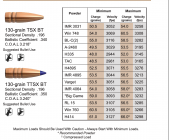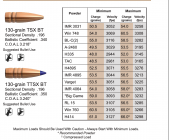Below is what I received from Barnes on the subject. I sent them an email before I decided to switch my powder from Benchmark to Varget (was able to get some from 10ring yesterday).
Posting for reference.
If wanting to use a powder/bullet we do not have load data listed, you can use "other" (jacketed lead core or monolithic) bullet load data when loading a Barnes Bullet of equal (or close to) weight. Using data from HodgdonReloading.com or other sources/powder/bullet manufacturers. JUST BE SURE TO START AT THE MINIMUM STARTING LOAD and work up from there in half grain increments watching for signs of high pressure such as, a sticky (hard) bolt lift when ejecting the fired case, ejector mark on the case head stamp or flattened/leaky primers. Once you notice any of the high pressure signs then you will want to lower the charge about half a grain or so to where no high pressure signs are present, and that would technically be "YOUR" rifle's max load. The load data published by all of the companies is just a reference point/guideline to safely start out at the minimum charges. The MAX charge solely depends on your rifle's chamber, barrel length, powder lot #, brass case capacity/manufacturer and your environmental conditions. Using a website,
loaddata.com’s “THE ULTIMATE RELOADING MANUAL” for the sole purpose of finding specific load data can be a huge time saver.
When loading a Barnes TSX, Tipped TSX or LRX bullet, your rifle may prefer a bullet jump of anywhere between .050” up to .250” or more. This distance off the lands (rifling), aka “jump” may be limited to the rifles throat length, magazine length and bullet length.
When selecting the cartridge overall length (COAL) we recommend starting with a minimum “jump” of .050” off the lands. This is the point where your load development should begin. You can then later test different seating depths and find a “sweet spot” that your particular firearm prefers. We suggest working in at least .025” increments as follows seating the bullet deeper to allow a further jump. Your test plan could look something like this:
1st group- .050” jump
2nd group- .075” jump
3rd group- .100” jump
4th group- .125” jump
5th group- .150“ jump
6th group- * see below
This length can be determined by using a “Stoney Point Gauge” or other methods/tools designed to determine your rifles best COAL. You do not have to seat the bullet at, or on one of the cannelure/pressure relief rings. The pressure relief rings have nothing to do with seating depth; ignore them! Remember, there are many factors that may control or limit the seating depth for your application. You may find that you need to start at around 0.150” off the lands and are not able to get any closer due to limiting factors including proper neck tension and magazine length.
*In rifles that have long throats you may be limited on how close you are able to get the bullet to the lands. In these instances, it is not uncommon to find the best accuracy with a jump of .200” or more.
This jump may possibly stay the same regardless of powder or charge weight within a given rifle. If preferred accuracy is not obtained, we certainly recommend trying another powder, for the powder type and charge greatly affects the overall accuracy of each individual firearm.
FYI- An accurate load requires a bullet with the proper consistent case neck tension which leads to more constant pressures and velocities.
Using the above two processes, I’d use the load data for the 130 gr SPR HP bullet on the Hodgdon powder website. Make sure you begin with the Starting Load of 48.0 gr and work up.
Thank You
Alan | Consumer Service
Barnes Bullets
















